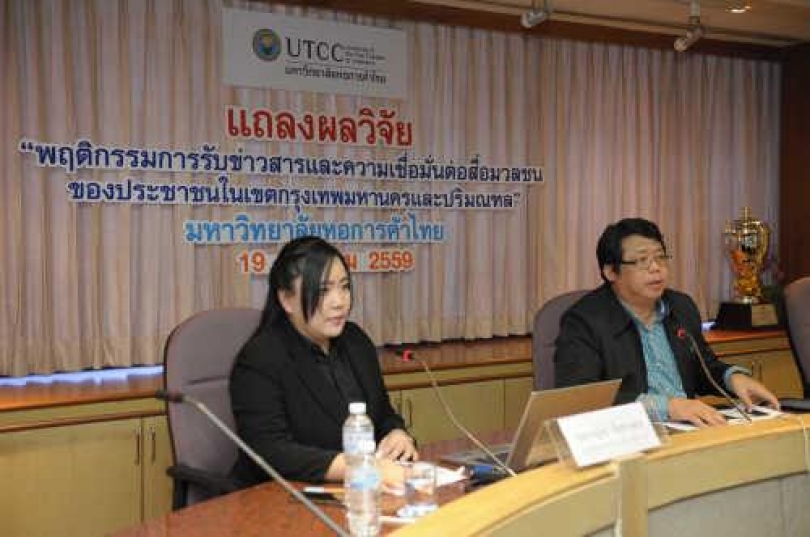Mainstream media is the most trusted news sources: survey

THAI CONSUMERS today are more likely to turn to social media for news consumption, but mainstream media are still the most trusted sources of news, according to research by University of the Thai Chamber of Commerce’s School of Communication Arts.
The survey on “the public’s media-exposure behaviour and trust towards the press” was conducted in July on 800 participants in the Bangkok metropolitan area.
The participants were 44 per cent male and 56 per cent female. About 52.8 per cent had bachelor’s degrees, and 22.8 per cent had secondary-school education.
There were four age ranges, with 65.1 per cent Generation Y (aged between 19 and 36 years), 21 per cent Generation X (aged 37 to 51), 7.5 per cent baby boomers (52 to 70), and about 6.4 per cent Generation Z (aged between 12 |and 18).
Mana Treelayapewat, dean of the School of Communication Arts at UTCC, revealed the findings of the survey.
The findings indicated that 32.6 per cent of the population of Greater Bangkok spend about one to two hours a day consuming news, and 24.1 per cent spend two to three hours a day taking in news.
The most frequently consumed news was about entertainment at 54.4 per cent, followed by key incidents at 52.3 per cent, sports 37 per cent, politics 34.9 per cent and crime 32.8 per cent.
Respondents reported that they most often got news from social media, with the score 4.13 out of 5, followed by watching television (3.81) and news websites or applications (3.15).
Most participants consume news from online sources through mobile devices, with an average score of 4.35 out of 5, more frequently than through a computer, with an average score of 3.12.
They choose to read news stories that are shared by other people close to them, with an average score of 3.53 out of 5, followed by reading items from official news agencies (average score 3.33) and unofficial news sources (3.28).
Once people see news stories, most click on the news sources (average score 3.33), followed by clicking “like” (3.03).
In the past three months, the most watched morning news programme was “Rueng Lao Chao Nee” on Channel 3HD (48.9 per cent), followed by “Chao Nee Tee Mot Chid” (26.4 per cent).
As for news programmes at noon, “Tieng Wan Tan Hade Karn” on Channel 3HD and “Hong Kao Park Tieng” on Channel 7 were the most watched, both with 23 per cent.
The most watched evening news programmes were “Rueng Den Yen Nee” on Channel 3HD and Channel 7’s “Evening News”.
In late evening, the popular news programmes included “Kao Sam Miti” on Channel 3HD at 46 per cent, followed by “Pra Den Ded Jed See” on Channel 7 HD with 31.5 per cent.
The most watched weekend news programme was “Rueng Lao Sao Artid” on Channel 3HD at 42.1 per cent, followed by Channel 7’s “Evening News” with 27.9 per cent.
“As we can see, the public’s media exposure behaviour mostly focuses on taking in news from social media,” Mana said. “Moreover, they are more exposed to news that is shared by those close them and peers than official news sources.
“Interestingly, the public follow news stories reported by unofficial news sources as often as the ones reported by official news agencies. Thus news agencies as professional journalists should keep raising the bar on their methods, forms and news content in order to differentiate their content from other online content to persuade the public to prefer to follow news content reported by official news sources more.”
Kanokkan Bunchabusabong, |a lecturer at the Strategic Communication Division, School |of Communication Arts, UTCC, revealed the findings on the public’s trust towards the press.
The key findings were that the most trusted news sources are official news agencies, with an average score of 3.67 out of 5, followed by news content shared by close peers (3.01) and unofficial news sources (2.97).
People trust television news reports the most, with an average score of 3.89, followed by newspapers with 3.66, radio with 3.22 and news websites and applications with 3.17. Social media are the least trusted news sources, with an average score of 3.06.
People think television news programmes (70.5 per cent) can report on political and social |issues with the most dimensions, followed by news websites and applications (56.9 per cent), newspapers (55.8 per cent), radio |(55 per cent) and social media |(54.4 per cent).
The element that creates |the public’s trust in news reporting the most is content (48.8 per cent), followed by affiliations (32.6 per cent), news anchors (10.5 per cent) and journalists (8.9 per cent).
The findings in relation to the public’s trust emphasise the changes in media-exposure behaviour with the increase in the use of social media, news websites and applications to take in news. However, people still trust mainstream media, especially television.
They believe that television news can report news stories with several views and dimensions.
Furthermore, the research team analysed the findings by generation.
Baby-boomers aged between 52 and 70, “Do not trust = Do not consume” is their concept of news consumption. They consume news from their trusted sources. “They like mainstream media, and they are likely to prefer new media.”
As for Generation X aged between 37 and 51, their media-exposure behaviour can be called “FOMO”, of fear of missing out. Therefore, they are more likely to take in news from online sources and their peers. However, they still say they trust mainstream media more than new media.
Generation Y (19-36 years old) “use new media but trust mainstream media” as well. Social media are used most frequently by Generation Y, followed by television, news websites, applications, newspapers and radio. Their most trusted news sources are television and newspapers rather than new media.
Finally, Generation Z (12-18 years old) “are addicted to new media but still trust mainstream media”. This generation consumes news from social media more than other age groups, but they still report that they trust television the most. “Interestingly, the overall findings show that the younger the generation, the more they trust news that they consume through social media. However, the public still trust the mainstream media, especially television. Thus in the era of modern news consumers, the media must adjust themselves to align with the changes by combining the mainstream media that are more trusted and new media that are becoming part of their lifestyles,” Kanokkan said.





